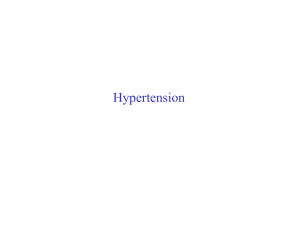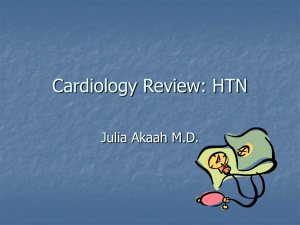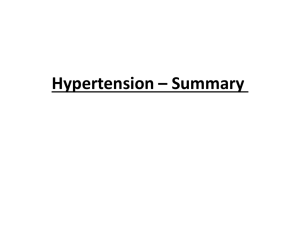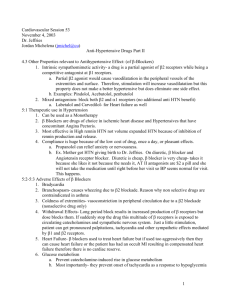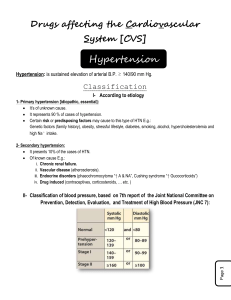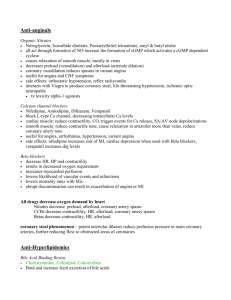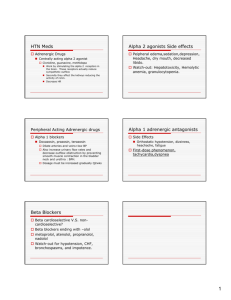Hypertension
advertisement
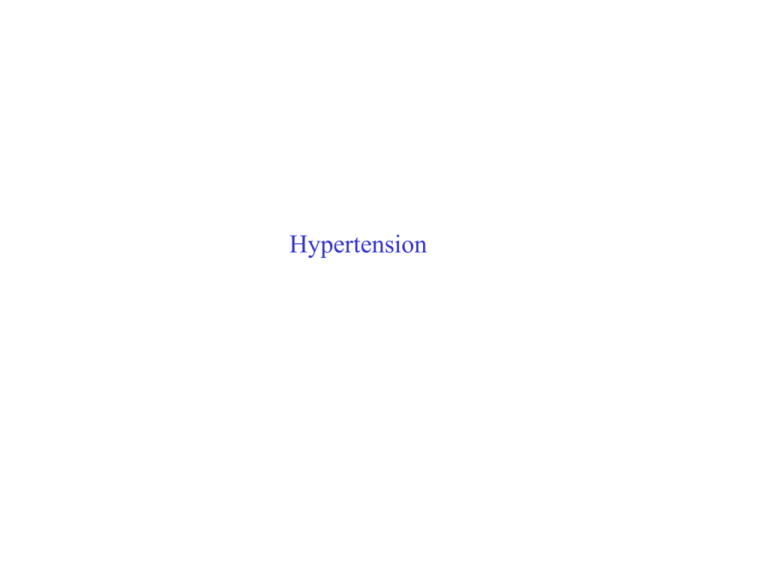
Hypertension Normal BP: <120/<80 Prehypertension: 120-139/80-89 Hypertension stage1 140-159/90-99 Hypertension stage 2 160/100 Emergency >210/>120 Drugs used for treatment of hypertension: •Diuretics •Centrally acting agents- methyl dopa, clonidine •-Adrenoceptor blockers •-Adrenoceptor blockers •Combined and blockers •ACE inhibitors •ARBs •CCBs •Vasodilators Hydralazine, Minoxidil, Diazoxide, Fenoldopam (arteriolar) Sodium nitroprusside (arteriolar + venular) Need for life-style changes: •Weight loss/control •Restricted sodium intake •Increasing aerobic exercise •Moderating alcohol consumption These changes in life-style may be sufficient to control hypertension in early stage I They also facilitate pharmacological treatment Diuretics: •Thiazides, loop diuretics and K+ sparing diuretics They are antihypertensive when given alone Also enhance the efficacy of other antihypertensive agents Exact mechanism not known Initially decrease extracellular volume and enhance Na+ excretion by inhibiting Na+Cl- co-transporter which leads to in CO Long term therapy- CO and extracellular volume returns to pretreatment value due to compensatory mechanisms but antihypertensive effect persists due to decrease in PVR in PVR may occur due to direct vasodilatory effect of thiazides or due to their effect on kidney Sympatholytic agents: •Centrally acting: methyldopa, clonidine • Adrenoceptor blockers • Adrenoceptor blockers •Combined and adrenoceptor blockers- labetalol, carvedilol Methyldopa: •It is an analog of DOPA (dihydroxyphenylalanine) •It is a pro drug- metabolized in brain by L-aromatic amino acid decarboxylase in adrenergic neurons to methyl dopamine and then converted to methyl norepinephrine • Methyl norepinephrine is stored in the vesicles in place of NE and released in response to stimulus •Acts in the CNS to reduce sympathetic outflow from brain stem •Also, probably acts an an agonist of central presynaptic 2 receptors to reduce central sympathetic outflow •Rapidly absorbed, t½ approximately 2 h •Even after i.v. injection effects starts after a delay of about 6-8 h Tyrosine Tyrosine hydroxylase L-DOPA α-Methyl dopa Dopa decarboxylase Dopamine α-Methyl dopamine Dopamine β hydroxylase NE α-Methyl NE •Why the delay in action?: probably due to time taken for transportation to brain and conversion to methyl NE •ADRs: Sedation, transient Dryness of mouth Parkinsonian signs Hyperprolactenemia leading to gynecomastia/galactorrhoea May precipitate severe bradycardia/sinus arrest Hepatotoxicity- Coombs test (antiglobulin) necessary because autoantibodies are produced against Rh antigen Preferred drug for treatment of hypertension during pregnancy Clonidine, Guanbenz and Guanfacine: •Stimulate 2A subtype of 2 receptors in the brain stem and reduce the central sympathetic outflow • in plasma concentration of NE correlates with the decrease in BP •Decreased sympathetic outflow also reduces cardiac output & HR •In supine position, when the sympathetic tone to vasculature is low, the effect is mainly by reducing HR and stroke volume •In upright position, the vasculature tone is high and effect is mainly by reducing the PVR •Since they block peripheral vasoconstriction, postural hypotension may occur ADRs: •Sedation •Xerostomia •Dryness of eye, nasal mucosa •Parotid swelling •Postural hypotension •Erectile dysfunction •Bradycardia, sinus arrest, AV block •Rebound hypertension Guanadrel: •Exogenous false neurotransmitter •Actively transported to adrenergic neuron by NET (NE transporter) •Previously NET was known as Uptake 1 •Stored in adrenergic neurons where it is concentrated in storage vesicles and replaces NE •Released in place of NE and acts as false neurotransmitter •It has no activity on adrenergic receptors •This inhibits the functioning of peripheral adrenergic neurons •Antihypertensive effect is achieved by reduction in PVR •Postural hypotension -Adrenergic blockers: •Decrease HR, output and stroke volume (1) •Inhibit renin release from JG apparatus (1) •Block -receptors of peripheral blood vessels so they constrict (2) •PVR increases initially but gradually returns to pretreatment values or less •Those crossing the BBB also reduce central sympathetic tone •Do not cause retention of salt and water •Often combined with diuretics- additive effect •Highly preferred drugs for hypertensive patients with complications like angina, MI or CHF 1-Adrenoceptor blockers: •Block 1-adrenoceptors on smooth muscles of arterioles •Reduce arteriolar resistance and increase venous capacitance •Reflex increase in HR and plasma renin activity •Return to normal during long term therapy •Postural hypotension may occur depending on plasma volume •Reduce total plasma concentration of triglycerides and LDL •Increase plasma levels of HDL- beneficial effect •Effect on lipids persists even when combined with diuretics •Preferred in hypertensive patients with BPH Combined and adrenoceptor blockers: •Labetalol and carvedilol •Labetalol is a mixture of four stereoisomers- one isomer is blocker like prazosin, another is a non-selective blocker with partial agonist activity like pindolol •Other two isomers are inactive •Carvedilol: receptor antagonist + 1 receptor blocking activity •Pheocromocytoma? Nebivolol: 1 selective antagonist •Promotes vasodilation due to production of NO in arterial smooth muscle •Has antioxidant properties also Vasodilators: •Hydralazine: Directly relaxes the arteriolar smooth muscle Mechanism uncertain Does not relax venous smooth muscle Compensatory reflex increase in sympathetic outflow Increase in HR, cardiac output, plasma renin activity and fluid retention Selective decrease in vascular resistance in coronary, cerebral and renal vascular beds Postural hypotension- uncommon because it does not dilate veins ADRs: •Extension of pharmacological effects: headache, flushing, hypotension, palpitation, tachycardia, dizziness, nausea •Can precipitate angina or MI due to increased myocardial O2 demand •Immunological reactions- drug induced lupus syndrome, serum sickness, hemolytic anemia •Pyridoxine responsive polyneuropathy- probably because hydralazine combines with pyridoxine to form hydrazone Minoxidil: •Converted in liver to active form- minoxidil N-O sulphate •Produces arteriolar vasodilation •No effect on venous capacitance vessels •Causes increase in cardiac output •Blood flow to skin, skeletal muscles, GIT and heart is increased •Dilates renal artery, nett effect depends on hypotension and extent of dilatation •Potent stimulator of rennin secretion- by increasing sympathetic outflow and effecting renal regulation of renin release •Minoxidil sulphate opens ATP-modulated K+ channels •K+ efflux occurs, cell is hyperpolarized ADRs: •CVS: same as hydralazine •Hypertrichosis: (abnormal hair growth in the body) may occur Uses: •Severe hypertension- should never be given alone; always with a diuretic to prevent fluid retention and a sympatholytic drug to control reflex CVS changes •Baldness- topical Diazoxide: •Chemically related to thiazide diuretics but has no diuretic activity •Instead causes retention of sodium and water •Acts by opening K+ channels in arteriolar smooth muscle cells •No effect on venules •Causes hyperglycemia •Used for short term treatment of hypertensive emergencies •Often combined with a diuretic and a blocker Fenoldopam: •Agonist of dopamine D1 receptors •Causes dilatation of arterioles and natriuresis •Oral bioavailability is poor •t½ approx. 5 min •Onset of action is rapid •Increases renal output, creatinine clearance and sodium excretion so concomitant use of diuretic or blocker is not required •ADRs: reflex tachycardia, headache, flushing •Increases intraocular pressure so should be avoided in glaucoma Sodium nitroprusside: •Releases NO which dilates the blood vessels •Mechanism of NO release not known but mimics endogenous NO release by vascular endothelial cells •No development of tolerance (it occurs to nitroglycerine) •Dilates both arterioles and venules •CO falls due to venous pooling and reduction in PVR •Plasma renin activity increases •Unlike arteriolar dilators hydralazine, minoxidil and diazoxide, it causes only modest increase in HR and reduces cardiac O2 demand •Used to treat hypertensive emergencies, aortic dissection, controlled hypotension during anesthesia •Effect of light on drug
